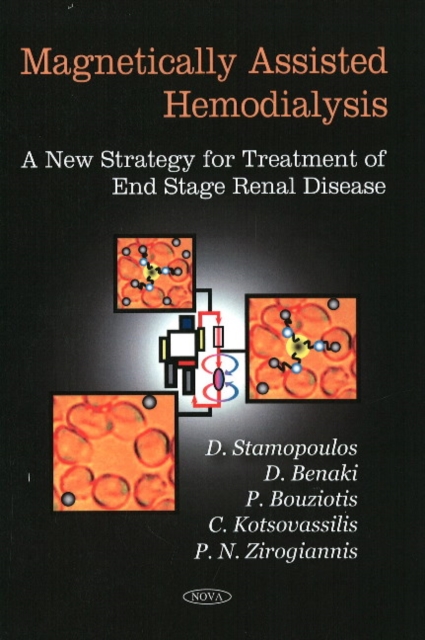
Magnetically-Assisted Hemodialysis : A New Strategy for Treatment of End Stage Renal Disease Paperback / softback
by Dimosthenis Stamopoulos, D Benaki, P Bouziotis
Paperback / softback
- Information
Description
In the present book the authors introduce the utilisation of FNs in the concept of Magnetically Assisted Hemodialysis (MAHD) for the treatment of End Stage Renal Disease (ESRD).
ESRD patients have to be subjected to permanent Hemodialysis (HD) therapy having a typical schedule of three 4-hour sessions per week.
The proposed strategy of MAHD aims to become a more efficient development of conventional HD.
The core of the idea is the production of Ferromagnetic Nanoparticles-Targeted Binding Substance Conjugates (FN-TBS Cs) constructed of biocompatible FNs and a specifically designed TBS.
The TBS part is necessarily used for increasing the biocompatibility of the FNs host carriers, but most importantly should have high affinity and binding capacity for the specific Target Toxic Substance (TTS) that should be removed from the patient.
For these demands to be fulfilled, antibodies or even specific proteins could serve as the TBS part of the desired FN-TBS Cs.
The FN-TBS Cs should be administered to the patient timely prior to the MAHD session so that, owing to their free circulation in the vascular network, they will be able to collect the desired TTSs through their adsorption onto the TBS part of the Cs.
However, long residence times of the FN-TBS Cs in the blood stream cannot be used so that noticeable triggering of the reticuloendothelial system to be avoided.
As a result, the binding dynamics of the FN-TBS Cs with candidate TTSs are of major importance.
Eventually, the complex FN-TBS-TTS can be selectively removed during the MAHD session by means of a "magnetic dialyser", that is an external magnetic field applied either at the conventional dialyser or at other point(s) along the extracorporeal blood circulation line of the dialysis machine.
The advantages of MAHD over conventional HD are discussed in detail among issues of practical importance.
Some of the main advantages are the following: (i) Increased rate of toxin removal, (ii) Selective targeting of specific TTSs and prevention by the respective disorders during early stages, (iii) Decreased duration of each dialysis session, and (iv) Adjustment of the blood flow rate to relatively lower values.
Apart from these primary benefits related to the comfort and overall health status of the patient, enormous financial benefits will also evolve for National Health Budgets despite the fact that the proposed MAHD strategy requires small investments for the only modest modification of existing dialysis machines.
The authors hope that the utilisation of MAHD into clinical practice will become a reality in the near future so that long-term-HD patients will benefit from all the advantages discussed here, and from many more that will probably evolve after intense {in vivo} applications are completed.
Information
-
Out of StockMore expected soonContact us for further information
- Format:Paperback / softback
- Pages:95 pages, Illustrations, unspecified
- Publisher:Nova Science Publishers Inc
- Publication Date:01/11/2008
- Category:
- ISBN:9781604566819
£132.99
£74.72
Information
-
Out of StockMore expected soonContact us for further information
- Format:Paperback / softback
- Pages:95 pages, Illustrations, unspecified
- Publisher:Nova Science Publishers Inc
- Publication Date:01/11/2008
- Category:
- ISBN:9781604566819